Hamming it Up
By Adam West, South Pole correspondent
September 21, 2017
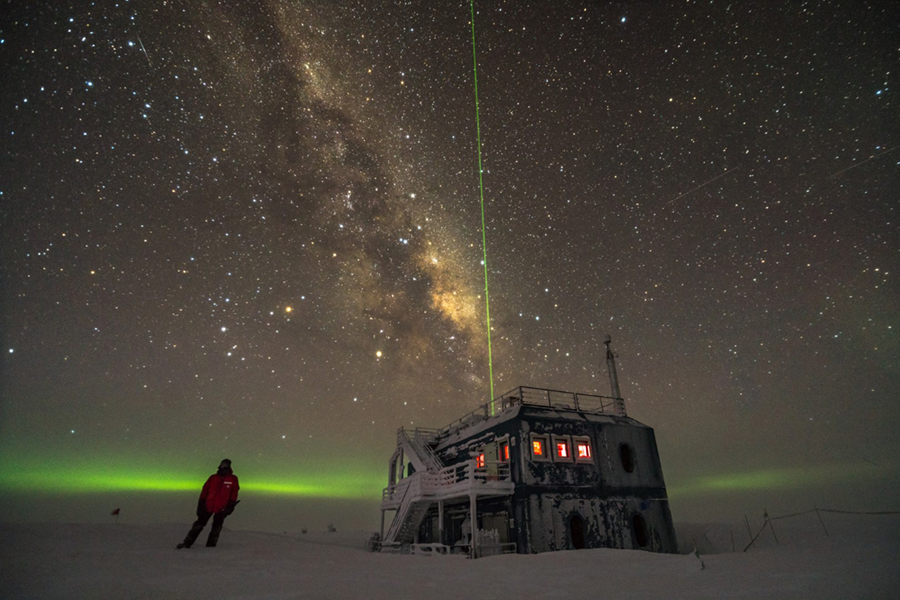
Photo Credit: Martin Wolf NSF/IceCube
With the Milky Way in the background, a green laser shoots into the sky from the Atmospheric Research Observatory, measure atmospheric turbulence.

Photo Credit: Martin Wolf, IceCube
Illuminated from the inside, station residents set up a Scott tent near the geographic south pole, a shelter similar to what the earliest polar explorers used.
The station has mostly settled into a routine for the winter, and a number of exciting events took place during the month of August. On the 13th, a number of station residents set up a Scott Tent as a prop at the Pole in order to take some interesting photographs of the tent under the auroras. This tent a similar style to those used by the explorers on early Antarctic expeditions like Roald Amundsen and Robert Falcon Scott, for whom South Pole Station is named.
Due to confusion over the entry requirements, South Pole did not participate in the annual Winter International Film Festival for the first time in many years. Despite this, each of the films from other stations was shown in the galley on August 20th so those interested could vote on their favorite films. These films were produced in 48 hours at the beginning of the month and had to include specific sounds, events, or props to qualify for inclusion in the official film festival. These details are created by participants at various stations and sent out to participating stations at the beginning of the production period.
Over the past few years, the South Pole has had an annual winter-over pool tournament. This year was no different, with 22 people participating in the double-elimination tournament. Some of the favorites to contend for the trophy were knocked out in upsets early in the tournament, paving the way for Josh Neff to take first place. Josh won the tournament last year as well, which makes him the first person to win back-to-back trophies. Machinist Matt Krahn came close, defeating Neff once in the final round, but lost the next game to take second place.
At the beginning of the winter season, IceCube scientist and amateur radio enthusiast James Casey taught a course on amateur radio for those interested in obtaining their ham radio licenses. While the class ended in June, due to some scheduling and satellite difficulties, it wasn’t possible to conduct the examinations until August. Through James’ tutelage and cooperation with volunteer examiners in the north, 11 of the station personnel earned their amateur radio licenses, with five of those earning licenses beyond the introductory level. With this license, these individuals can use the ham radio system at the South Pole to contact radio enthusiasts around the world, providing them also with practical, hands-on experience with radio technology.
Midwinter With a Side of Vanilla
By Adam West, South Pole correspondent
July 17, 2017

Photo Credit: Martin Wolf NSF/IceCube
A station resident stands outside in front of the IceCube laboratory with the Milky Way and southern lights overhead.

Photo Credit: LTJG Gavin Chensue NOAA
Station residents moved couches and chairs into the gymnasium to make an impromptu movie theater for the traditional showing of The Shining.

Photo Credit: Martin Wolf NSF/IceCube
Cooks and dining attendants serve up the annual Midwinter feast.
The month of June was an exciting one, especially with the celebration for the winter solstice: the sun has begun its long journey back over the horizon and winter is already almost halfway over. The station received a number of midwinter greetings from other Antarctic stations, all of which are on display along the wall to the galley. In the weeks leading up to midwinter, many station personnel submitted their designs for the newest marker for the Geographic South Pole and the winning design, as voted on by station residents, was announced during the midwinter dinner.
The midwinter celebrations were definitely a high point of the month. To celebrate the winter solstice, we began with a long-standing winter tradition at Pole on Saturday the 17th – watching The Shining on the big screen in the gym. On Sunday, the galley crew prepared a fantastic meal of steak and lobster with a side of potato pie and asparagus. The most incredible part was the delicious homemade vanilla ice cream. After the dinner, many of the personnel on station participated in a murder mystery party, attempting to solve the fictional murders of other station residents. About a dozen people on station participated as actors, coming up with elaborate backstories to justify their actions during the scenario. After a few hours of sleuthing, the murders were finally solved and the scenario drew to a close.
While it was nice to have an opportunity to relax, there is always work to be done here. The latest in the facilities upgrades has begun. The crew is working on replacing worn-out flooring in the hallway outside the galley. Due to the high traffic and heavy loads from bringing in supplies, the flooring in this area has worn out faster than in other parts of the station. While this project has slightly inconvenienced some station residents, it is an important project and it makes more sense to do it during the less-populated winter season.
The Station Abides
By Adam West, South Pole correspondent
June 14, 2017
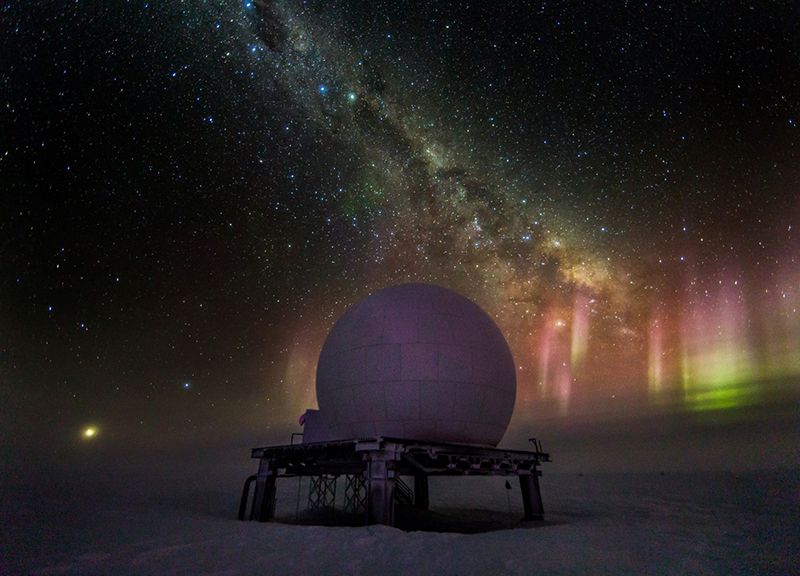
Photo Credit: Martin Wolf
The crescent moon rises over the station, illuminated in red light so as not to affect the all sky cameras observing the aurora overhead.

Photo Credit: Matt Smith
The aurora australis light up the sky behind the protective dome that houses the satellite dish that is the station’s primary communications link.
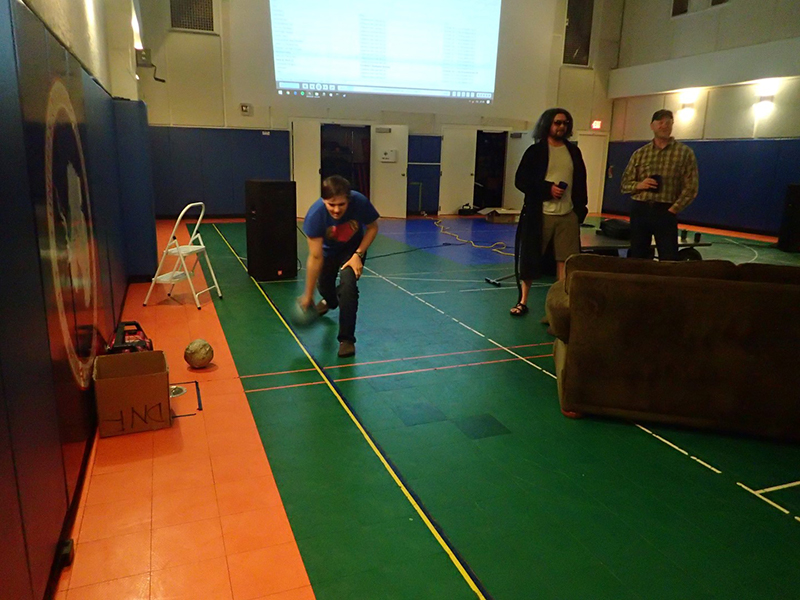
Photo Credit: Brett Baddorf
Station residents bowl at the public showing of the film The Big Lebowski.
Now that winter has officially set in, the station has been settling into more of a routine. In order to give the galley staff a day off, the kitchen is normally closed on Sundays, which means the crew will generally choose from a variety of leftovers in the fridge from the previous week’s meals. A handful of volunteers have taken it upon themselves to cook a few meals on Sundays and clean up afterwards, which has helped to keep the menu exciting.
Unfortunately, our best access to the internet has been inoperative for the month of May. A component failed at the ground station in Christchurch, which relays our internet connection to the DSCS satellite that the station connects to. Satcom employees from Denver, Pole, and Christchurch have been working hard throughout the outage to restore connectivity. While the system has not been restored yet, everyone at Pole is hopeful that it will be repaired by the time Midwinter rolls around in June.
On May 28th, most of the station got together in the gym to watch the movie The Big Lebowski. The I.T. department set up a projector and volunteers helped move couches and chairs from the lounges on station to the gym to provide seating. In addition, a bowling lane was set up in one of the corners and a rug was found to really tie the room together. Almost everyone on station showed up to watch, many of them wearing costumes inspired by characters in the movie.
As for recreation, many of the activities that began over the summer are continuing through the winter, as well as a few new activities that have been introduced. One of these new additions is the winter poker tournament, of which two rounds have been completed. The tournament is modeled after the World Series of Poker; however, instead of gambling, the contestants play for points and the possibility of being named the best poker player on station this winter. The turnout for this tournament has been fantastic, with around 12 to 15 players participating during each round. With about 10 rounds planned over the course of the winter, it is still up in the air as to who will be crowned the champion.
Darkness Falls
By Adam West, South Pole correspondent
May 8, 2017

Photo Credit: Martin Wolf, IceCube
The moon shines brightly over the IceCube facility.
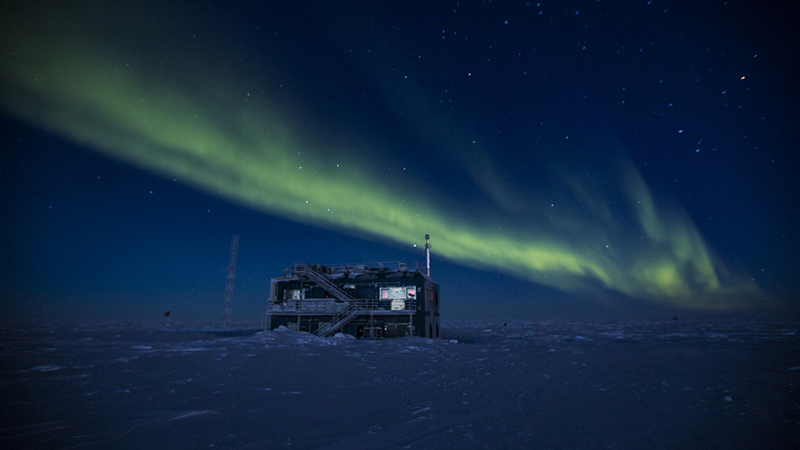
Photo Credit: LTJG Gavin Chensue-NOAA
Aurora illuminate the Atmospheric Research Observatory at the edge of the clean air sector.
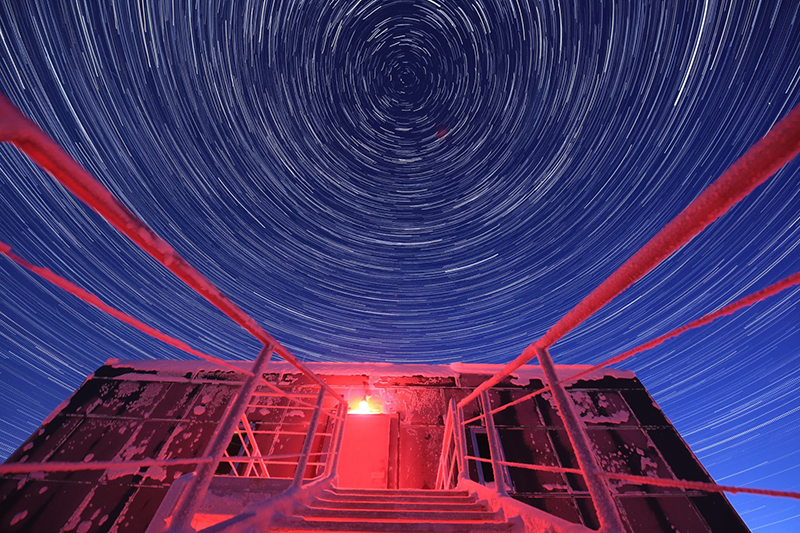
Photo Credit: Hunter Davis
A timelapse photo captures the star trails over one of the rear entrances to the elevated station.
It is now completely dark! For the first few weeks after sunset, some residual light still lit the edge of the horizon; allowing residents to mark the location of the sun but preventing the stars from becoming visible. Now that the sun has disappeared entirely, the station is treated to frequent auroras and amazing views of the night sky. One of the scientists on station is giving weekly lectures on a number of topics in astronomy, as well as taking people out to point out different constellations and other features of interest in the night sky. Other station personnel are sharing their knowledge on a number of topics, including amateur radio, welding, and language classes.
As well as providing stunning light shows, the auroras are used by a number of projects to provide scientific data on the Earth’s upper atmosphere. A suite of cameras and auroral imagers came online in the middle of April and will collect scientific data through the end of the winter season. Some of these cameras are so sensitive that those working outdoors have to be careful when using flashlights so as not to damage them. To prevent any light pollution from the station, all of the station windows have been covered with cardboard and foam. The windows are so heavily tinted for the intense constant summer sun that they are not incredibly practical during the winter anyway. Many of the station personnel have taken to decorating the window coverings in the hallways and their rooms with pictures or drawings of personal interest.
The facilities maintenance projects continued this month, including another week of plumbing replacement. Again, a number of volunteers assisted with the project. The other major construction project for the season was the replacement and cleaning of the ductwork in the galley kitchen. This work lasted a total of three weeks, during which time the chefs worked out of the emergency kitchen located in the B1 pod. Cooking for 46 people in the emergency kitchen was no easy feat, but the galley staff rose to the challenge and continued to deliver good meals during the outage.
Polar Twilight
By Adam West, South Pole correspondent
April 13, 2017

Photo Credit: Martin Wolf, IceCube
In this stitched-together image, a weather balloon drifts off into the distance as the sun dips below the horizon.
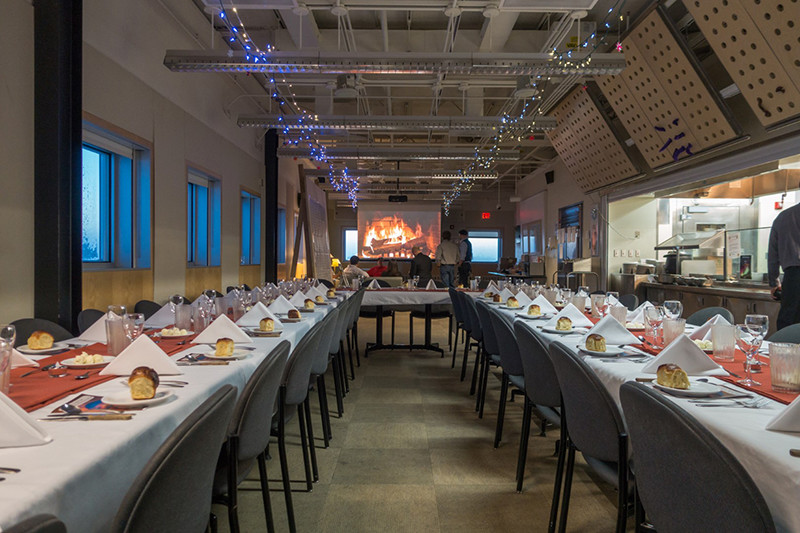
Photo Credit: Martin Wolf, IceCube
The station's galley was festively decorated for the traditional Sunset Dinner
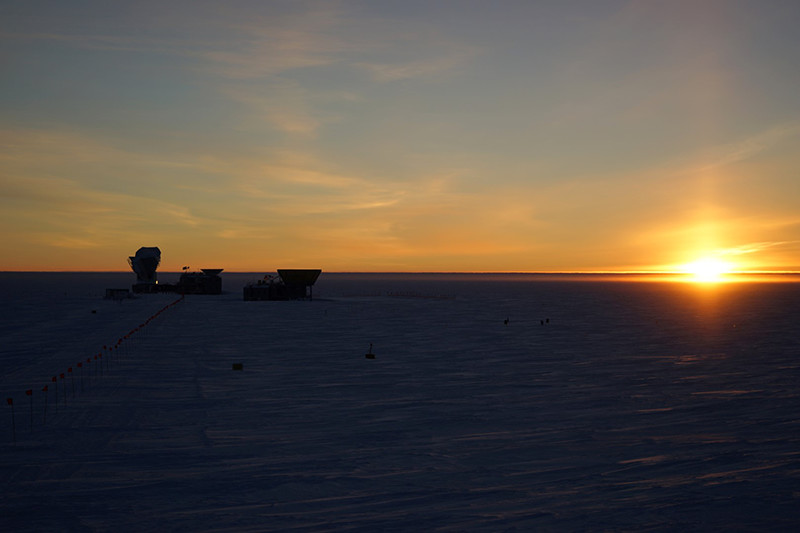
Photo Credit: Clint Perrone
The sun dips below the horizon behind the telescopes of the Dark Sector.
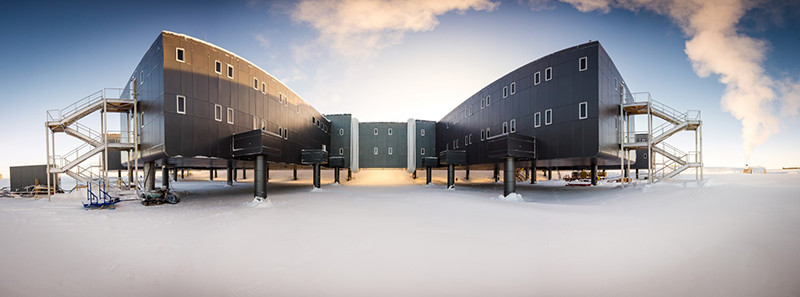
Photo Credit: Hunter Davis
Winter is a time to update and renovate different parts of the station while the population is at a minimum.
The sun has finally dropped below the horizon. The equinox took place on March 20th and the sun set over the next few days. Unfortunately for station residents, the sky was overcast during much of the sunset, but there were a few times where it cleared enough for us to catch a peek of the spectacular sunset. As the sun crossed the horizon, the green flash, an optical phenomenon that happens when sunlight refracts through many layers of the atmosphere, was visible for a few hours, but was mostly obscured by clouds. A lucky few people were able to glimpse the flash for a short while in the early morning when the clouds cleared out some.
The Sunset Dinner, a tradition at the South Pole to mark the transition into about five months of darkness, was held on March 26th. The chefs served three courses: a salad made from vegetables grown in the station greenhouse, crispy duck and bison steak for the main entrée, and a selection of desserts, which included crème brûlée, chocolate truffles and a fruit salad. We harvested more than 30 pounds of vegetables from the greenhouse for the salad and main course. As is usual for the traditional holiday dinners, volunteers from around the station helped to set up the galley, serve the meal and clean when everything was completed.
On Monday the 27th, the projects located in the Dark Sector held their annual open house, inviting all the station personnel to visit and learn about the science taking place. The open house allowed the station residents to learn more about IceCube, the South Pole telescope, and the BICEP and KECK telescopes. The tour of each project lasted about an hour and was very interesting.
Major facility maintenance projects have begun, starting with the replacement of the plumbing system in the B-Pod of the station. Many of the original copper pipes are being updated with PVC piping. The upgrade required that the water in the B-Pod be shut off for a few days, but the residents of these pods were able to adapt accordingly. As there is only one plumber on station, volunteers from a few other departments, including the carpenters and medical staff, helped out with the installation of the new plumbing system. There will be continuing maintenance projects over the next few months, but it was a relief to get the first stages of this project done early in the winter.
The First Month of Winter
By Adam West, South Pole correspondent
March 8, 2017

Photo Credit: James Casey
Before one departs on the last flight for the nine months of winter, two people embrace in front of an LC-130.
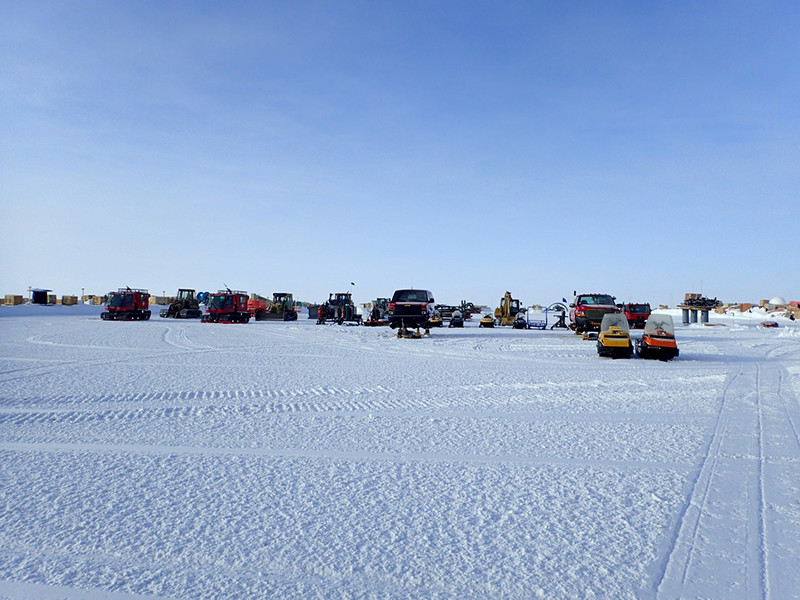
Photo Credit: Brett Baddorf
As winter sets in and temperatures drop, vehicles are moved to inside storage.
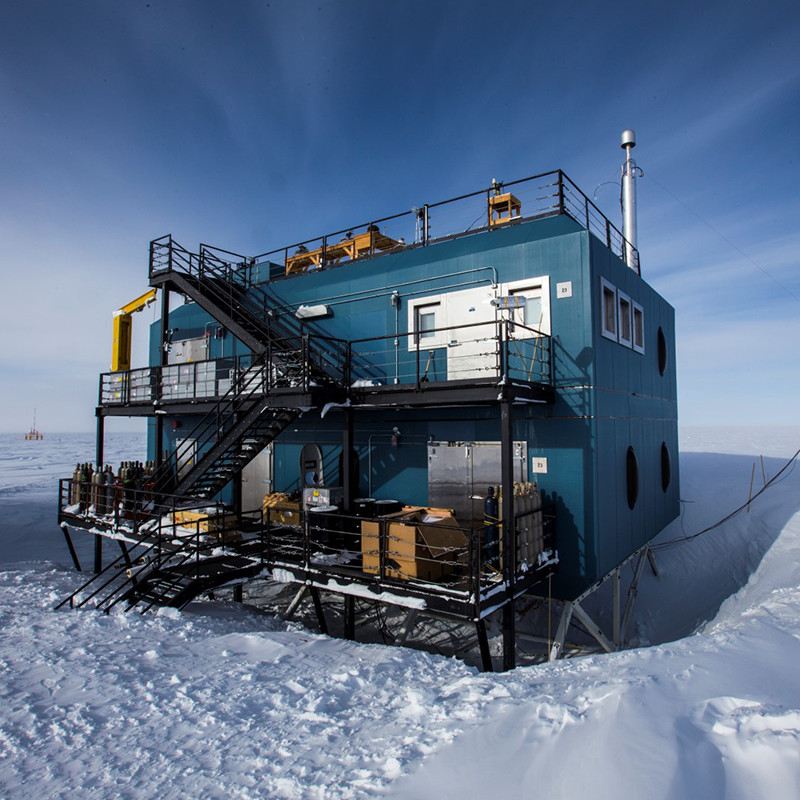
Photo Credit: Gavin Chensue
The Atmospheric Research Observatory at the edge of the South Pole's clean air sector is prepared to make atmospheric measurements and observations throughout winter.
The station is officially in winter mode. The last LC-130 flight departed on the evening of Feb. 15 and the last KBA Basler and Twin Otter planes have left as well. The 46 personnel remaining will make up the 2017 winter crew until the summer season starts at the end of October or early November. The station population dropped dramatically over the final week of the season, with about 100 people departing over the last handful of flights.
To celebrate the beginning of winter, we had a marathon viewing on Feb. 18 of each version of The Thing. We started with the 1951 The Thing from Another World, followed by the 2011 and 1982 versions. This is a winter-over tradition that began many years ago. As a station, we elected to watch the movies on Saturday, so that most of the personnel on station could participate. We moved most of the couches and chairs from the station into the gymnasium and the films were projected onto a screen attached to the wall.
With the close of the station comes new recreational opportunities; a tradition at South Pole is to hold the “Run to McMurdo” after the station officially closes. Participants in this event use the winter months to run, walk, bike or row the 830-mile distance between the South Pole and McMurdo Station using the cardio equipment in the gym. Distances completed on the bike or rowing machine are subject to correction factors to give a distance equivalent to running or walking. So far, about a dozen people have signed up to participate and many are ahead of the pace required to complete the challenge.
As the sun sinks closer to the horizon and the temperatures fall, the normal operating procedures at the station continue to change. Many of the vehicles, including the track van, snowmobiles, and Pisten Bullies, can’t operate much below -40 degrees, so most have been winterized and placed in cold storage until it starts to warm up again in the spring. The station electrician has taken down the outdoor vehicle plug-in line and the few vehicles that will remain operational during winter have been moved into our Vehicle Maintenance Facility.
Summer’s Almost Gone
By Adam West, South Pole correspondent
February 23, 2017

Photo Credit: Gwenhael de Wasseige-IceCube/NSF
Participants in the South Pole Marathon and Half Marathon line up along the race’s starting line.

Photo Credit: Martin Wolf
The South Pole Overland Traverse, or SPOT, delivered more than 100,000 gallons of fuel to the station on the third traverse of the season.

Photo Credit: Clint Perrone
One of the station’s research assistants repairs a fuel tester.
The summer season is drawing to a close and a number of projects are finishing up and departing. Stuart Jefferies and his team imaged the sun for approximately 50 hours with their solar telescope, producing a large amount of data for them to analyze.
For teams staged at the South Pole ready to head out into the field, the weather finally cleared enough for the Twin Otter airplanes to fly them to their respective camps. The Automated Geophysical Observatory (AGO) team completed all of their required inspections, maintenance and installations, and the Gamma Ray Imager/Polarimeter for Solar Flares (GRIPS) recovery team was able to salvage a good amount of equipment from their balloon payload, which set down in the vicinity of the Pole.
The main recreational event of January was the South Pole Marathon and Half Marathon, which was organized by the station doctor, David Young. A small group of runners braved the cold, clear and windless conditions to complete the course, a route that took them past the solar telescope, the Dark Sector and Ice Cube Labs, down the skiway, and through the storage berms to a finish line at the geographic Pole. Everyone who started the race finished in time for dinner and a few who had originally only planned on running the half marathon ended up completing the full 26.2 miles.
We have been met by a number of distinguished visitors this season, the most recent being Anthony Bourdain, who stopped by South Pole Station for a day while filming a segment for his show “Parts Unknown.” He was given a tour of our kitchen, as well as the rest of the station.
The final South Pole Traverse team arrived on January 28, bringing in the last load of 104,000 gallons of fuel to run our generators for the next year. The fuel has now been completely offloaded and the team should be heading back to McMurdo at the end of the week. The last few flights coming in until station close will bring in some additional fuel to keep the tanks topped off, but the majority of our fuel has come from the three traverse teams bringing more than 300,000 gallons.
Polar New Year
By Adam West, South Pole correspondent
January 10, 2017

Photo Credit: David Young
Runners line up at the starting line for the Race Around the World, where participants run around the South Pole, crossing every line of longitude.

Photo Credit: Brian Vacha
Station residents festively decorated the station’s cafeteria for the big holiday meal.
South Pole station celebrated both Christmas and the New Year in a manner similar to Thanksgiving by taking Saturday off from regular duties to celebrate. On Christmas Eve the galley staff cooked a fantastic meal of Beef Wellington and lobster, with many delicious sides and a selection of desserts originating from different countries. On Christmas day, a number of station residents joined in the annual Race Around the World, which is a fun run around the station that passes by some of the research buildings on station, including the IceCube Neutrino Observatory, the South Pole Telescope and the Martin A. Pomerantz Observatory. In the tradition of the event, many participants dressed up in costume and a handful completed the course using snowmobiles or cross country skis.
The station community gathered in the gym on New Year’s Eve to celebrate the beginning of 2017 and to count down the final seconds of 2016. One of the live bands on station played early in the evening before giving way to a DJ to lead a dance party for the rest of the night. On New Year’s Day, the station gathered around the geographic pole to unveil the new marker and move it to its new location. This is necessary because the ice sheet the station is located on is moving at a rate of about 10 meters per year; the new location is surveyed each summer and each winter-over crew designs the pole marker for the next year.
Of course, there has been a significant amount of work accomplished over the last few weeks, including the second annual “Berming Man” on December 30th. For Berming Man, a number of people around the station volunteered to work out in the storage snow mounds, known as berms, behind the station to help clear off drifted snow and identify items to be returned back to the U.S. This year, the station was able to clear off a significant amount of snow from the A and C berms and remove boxes and items for projects that are no longer in operation at the station. At the end of the event, there was a celebration in the solar garage, which is a heated tent out by the berms.
As the month has continued, science and other facilities projects have made progress towards preparing the station for winter. The second of three traverse teams has come and gone, bringing a large amount of fuel to the station to help prepare it for winter. The Twin Otter on station has been busy bringing a few groups of scientists out to the field to monitor, repair and recover experiments.
Station News Home Page



























